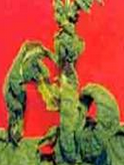Agricultural crops :: Cash crops :: Tobacco
Leaf Curl : Tobacco leaf curl virus
Symptom
-
Leaf curl, is fairly widespread in all tobacco tracts in India. Generally the disease appears 3-5 weeks after planting and sometimes late in the nursery.
-
The virus is transmitted by an insect vector, white fly Bemisia tabaci. It is also graft transmissible but not by sap or seed. There are a large number of hosts of this virus as well as of its vector.
-
The most characteristic symptom of tobacco leaf-curl disease is the production of leafy outgrowths known as enations from the veins on the lower surface of the leaves.
-
Combined with this, is a stunting of the whole plant and twisting and curling of the leaves.
-
The manifestation of the disease varies greatly according to environmental conditions and the variety of tobacco concerned
|
|
Management
-
Remove and destroy the diseased tobacco seedlings before and after planting whenever they are seen in the field. Fill the gaps with healthy seedlings if it is not too late.
-
Alternate weed hosts for whitefly should be removed and destroyed.
-
In endimic areas Sesbania sp. may be grown as a barrier crop around tobacco fields.
-
Install 12 yellow sticky traps (castor oil coated) per hectare to monitor the whitefly population. If 100-200 whiteflies stick to the trap the following insecticide schedule has to be adopted.
- 1st spray Chlorpyrifos 20% E.C. @ 25 ml. In 10 litres of water
2nd spray Monocrotophos 36%, W.S.C. @ 15 ml in 10 litres of water
3rd spray Acephate 75% S.P. @ 10 gm in 10 litres of water
4th spray Demeton-s-methyl 25% E.C. @ 15 ml in 10 litres of water
-
Spraying has to be done preferably in the evening hours (4-6 P.M) with high volume spraying and it should be ensured that the under side of the leaves also is covered.
-
Further the spraying schedule has to be adopted on community basis.
|
|


